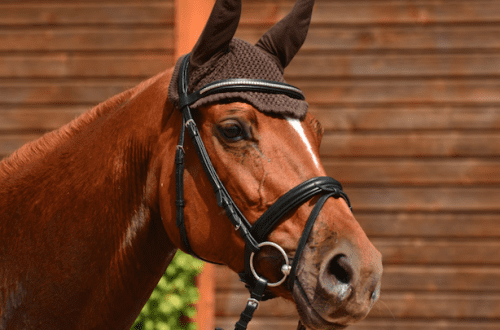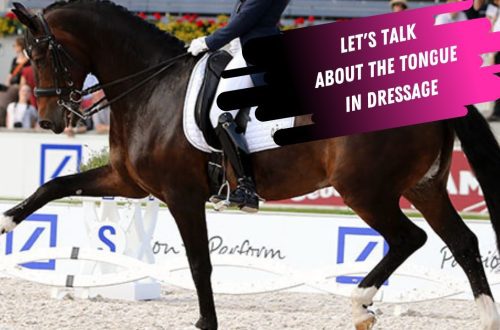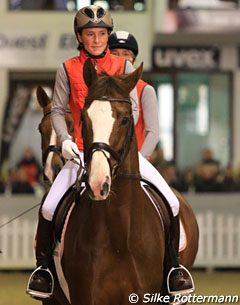
Ingrid Klimke: “Right driving is enough!”
Ingrid Klimke: “Right driving is enough!”
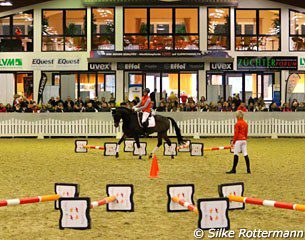
When Ingrid Klimke stepped into the center of the Westfalian Horse Center (Münster-Hahndorf), the 1700 spectators of the symposium froze for a moment. The main heroine of the day began her speech by reminding everyone of “the one place that was left empty today.” Her mentor and longtime friend of the Klimke family, Major Paul Steken, passed away just a few weeks ago at the age of 100. His simple but so precise phrase “Riding just enough” will serve as a reference point for generations of riders to come.
This article is a report on a symposium imbued with the spirit and style of the Klimke family.
Goal: “A contented horse that works as independently as possible”
Ingrid Klimke recalled her father’s motto, “Ride for your own pleasure.” From the very first minute she explained it as follows: the goal of her work is a happy horse that works independently. “Today we want to show you how this can be achieved,” she briefly described the program of the day.
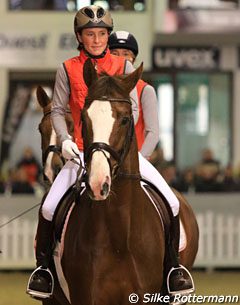
The inexperienced stallion Firlefranz follows the mare Geraldine into the arena, around which there are about 1700 spectators in the stands.
The first four-legged participants are a pair of red horses. Carmen Tiemann, Klimke’s groom for over two decades, riding the mare Geraldine. Following her is Ingrid on a stallion named Firlefranz, whose wheaten mane and clearly high spirits immediately attracted the attention of the audience. Four-year-old Ingrid, the son of her outstanding stallion Franziskus had probably never been to such an arena and was quite excited. Ingrid had the opportunity to demonstrate how to cope with such a difficult situation and give the horse confidence in the surrounding atmosphere. This is especially important if the horse is going to have a sporting career.
“At the beginning of the warm-up phase, it is important to ride as long as possible,” she explained. Until her the long-legged colt was still confused, she put her words into practice. Skillfully using the comparatively more experienced mare Geraldine as her “lead horse,” she directed Firlefranz after her, and he began to focus more and more on his smiling rider.
“Geraldine used to be rather timid, but now she is bolder,” Ingrid said of the mare, who seemed so relaxed and confident, as if this arena was her home. Klimke emphasized that in the warm-up phase the rider must achieve rhythm, relaxation (losgelassenheit) and also soft contact, “but in such a way that the horse is active, trying but not rushing.”
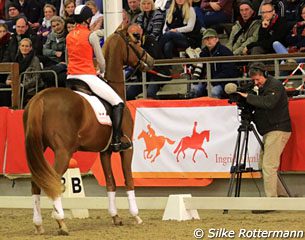
Firlefranz carefully examines the camera.
When Firlefranz was frightened by the cameraman filming the symposium, Ingrid elaborated on how to deal with such a situation (who has not encountered her, whether in the arena or in the fields?).
Klimke turned the young horse towards the object of his fear, reassuringly. While all the spectators saw that the young stallion was still worried (head up, ears forward), he also showed confidence in his rider, not trying to run away or dodge the “horse eater”. Subsequently, Ingrid rode it a couple of times in a large circle around the camera before proceeding with the exercises. She also rode up to the camera again with a shorter rein and a shoulder inward. As a result Firlefranz stopped responding to the camera at all, just like his older, more experienced girlfriend Geraldine. Since he had learned his lesson, he was “rewarded” with a long rein.
Calmness and relaxation as key factors
After this rather difficult ride on her young horse, the two-time Olympic champion and Rio silver medalist dismounted and remained on the ground, escorting her two riders.
Her new student Sofia Schulz Eistrap and her former student Lara Heggelmann rode two five-year-old descendants of the famous Fürstenball into the arena.
Schulze Eistrap rode a beautifully built black mare named Farlana TS:
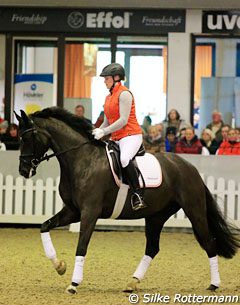
The pair worked on suppleness and continuity by doing multiple loops in both directions, a great tool in training the horse. Despite the fact that Farlana TS is quite young, the mare became more and more relaxed during the alternating work, which also included cavaletti, stops and transitions. In particular, the first gains at the end of their ride were good proof that the horse handled the atmosphere very well and trusted his rider when she wasn’t nervous or in a hurry.
Ingrid pointed out to viewers that the mare was “becoming more and more relaxed. See how she plays with her ears. This indicates that she is still impressed, but trusts Sophia.” The happy snort of the athletic horse made Ingrid smile as it was a sign that the horse was relaxing. “It would be nice to hear it at every workout, if possible,” she said. Klimke’s new student finished her ride in a relaxed trot forward and down (“because we finish the work as we started during the warm-up”).
Lara Heggelmann rode the stallion Fürst Stern. The dark bay beauty worked on lateral movements and cavaletti in curved lines at the trot.
Then it was the turn of Ingrid’s 14-year-old daughter Greta Busaker. Riding a six-year-old mare named Soma Bay, who rode Ingrid’s saddle at the Bundeschampionat this year, Greta looked confident. “Soma Bay is a favorite in our stable. She always and with all her might tries to please you, ”said Ingrid about the nature of the mare. The audience also got the feeling that the mare is happy, at peace and loves to work with the rider.
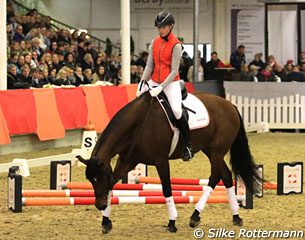
Soma Bay stretches forward and down, working under the saddle of Greta Busaker.
The pair worked on transitions between gaits, which Ingrid recommended to do at the beginning of the working phase. After the single change in the air and the walk pirouette, Ingrid emphasized the correct execution of the movements. She also gave a few brief remarks about the correct seat, which is a sine qua non for the correct performance of the horse. Soma Bay at the end of the lesson, showing a perfect “book” forward and down stretch, proved once again that the training helped her relax. The rider held the reins by the clasp, and the mare rounded her back pleasantly and stretched forward and down from the withers. Although proper stretching forward and down seemed natural to all Klimke horses in movement that day, it was a good opportunity to show the audience how she should ideally look. Often the stretch is done incorrectly and the horse falls on the forehand (unfortunately this also happens at the Bundeschampionat). Thus, deep stretching can be clear evidence of how well a horse is working and learning.
At the end of Soma Bay’s performance, the audience had the opportunity to ask Ingrid questions.
Referring to riding Soma Bay, one spectator remarked that “the mare is working very well, she has a very well developed trot.” This prompted Klimke to re-emphasize the value of good training: “Every horse can learn a good trot. This gait can be developed in any horse, and Soma Bay has not yet reached its peak, there is work to be done and where to go.” At a time when, according to Klimke, “modern horses are so beautiful and light,” it’s all too easy to forget that training should improve them, not just teach certain movements. This remark of hers seemed to be especially important.
graceful ride
Photos of Ingrid or her senior employee Carmen riding dressage or triathlon bareback horses and cordeo have long been known to the public. While some may assume that this is just a well-directed photo shoot to show how obedient and trustworthy Klimke’s horses are, Ingrid also uses the cordeo for training, believing that with the right use it can make riding even more refined. and graceful.
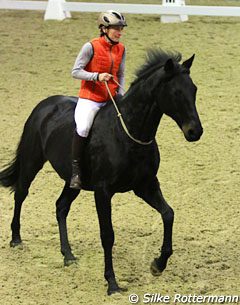
Two-time Olympic champion, 19-year-old Abraxxas and his groom, with whom they have been together for many years, Carmen Timan.
After a break, a 19-year-old “almost thoroughbred” thin and sonorous Hannover Abraxxas appeared on the arena. Of the ammunition, it turned out to be only a cordeo. Under his rider Karen, he demonstrated changes in the air, transitions, reins, jumps over obstacles. All this in perfect balance. The friendliness, calmness and willingness of the horse to cooperate were surprising, especially considering that he had a long career at high levels in the most demanding equestrian sport – triathlon. He was living proof that classic, gentle horse training keeps horses healthy and happy for years to come.
How cordeo can positively influence a horse and improve its ride was demonstrated by Klimke’s former student Sophie Lebeau, who now runs her own triathlon stable. Her eight-year-old gelding Captain Veterano was described as “sometimes a bit overly motivated”, and indeed, he was slightly turned on by the atmosphere of the event.
“The rider in these situations must remain calm and breathe deeply. It is better to hold the cordeo in one hand and try to get the attention of the horse. It also works with a horse that lies down on the reins,” Ingrid said. As for Captain Veterano, who was increasingly focused on working on cavaletti and lateral movements, Ingrid said that “he is able to work better, but we have to sometimes compromise and be content with what we have for the current day.”
“A good rider asks himself questions”
Ingrid is a member of an equestrian dynasty who continues to practice acquiring the correct lunge position, despite the fact that this tradition is falling out of fashion these days. More experienced riders can improve their ride in even more efficient ways. Using the example of 15-year-old Johanna Schulz-Thier riding a 12-year-old Ceon, Klimke showed several ways to improve and strengthen the seat. On a large circle opposite each other, the assistants placed two cones. The rider had to make the transitions between canter and trot clearly at certain points. The girl sat immaculately in the saddle, smoothly accompanying the movements of her horse during repeated transitions and did not interfere with her, did not lean back and did not pull the reins on herself during the half-halts.
Klimke made her point clear: “I strongly disapprove of riding sitting behind the vertical with the rider pushing and pushing. The rider must always follow the movements of the horse. If the legs are far ahead, the rider cannot bring the horse under his center of gravity. A good rider asks himself questions and sets clear goals. He always asks himself what he can improve? Body, mind and soul are one, so he must constantly be in tune with the horse’s mindset. It implies detachment from everything else. You need to give yourself to work with the horse completely.
Riding to Art
At the end of the symposium, Ingrid personally demonstrated two of her best dressage horses, Geraldine and Franziskus. Both horses qualify for the final of the Nürnberger Burgpokal in Frankfurt and have been successful throughout 2016. The horses are very different, both externally, and in character and in the manner of performing in the arena.
Ingrid first worked with Geraldine (“a powerful square type of horse that needs time to develop”). The mare cannot be called refined, but she is beautifully muscled, calm and absolutely “losgelassen” (relaxed). She showed herself well in front of a large audience. No one could ever imagine that once the granddaughter of a famous stallion named Tolstoi was a timid horse that needed serious support. “When Geraldine was 6 and 7, she was a little smaller than Franziskus, but this year she has matured and is now showing her full potential, she has come out of her shell. So, on gains at the trot, she moves many times better than before. And yet she remains a horse that is always with me,” said Ingrid. Geraldine showed everything that the rules of dressage require: soft elastic contact with the snaffle (simple), soft nape being at the highest point, nose always ahead of the vertical, her movements were free and flowed through her entire flexible body. Those little things that Judge Christoph Hess commented on did not overshadow the overall picture.
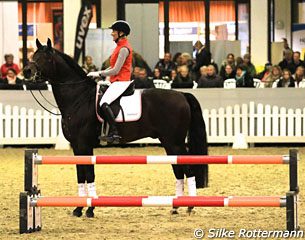
Franziskus entered the atmosphere after jumping a small obstacle.
While Geraldine was very relaxed from the start, the impulsive Westphalian stallion Franziskus took a few minutes to “get used to the atmosphere”. He is the same age as Geraldine. But he behaves differently – “Hello, here I am!” – as if believing that all those present gathered around only to appreciate his greatness. Ingrid recalled the time spent with him – everything did not always go smoothly, “but at some point Franziskus admitted that” it’s nice to work with the rider “”. She rode it in the Nürnberger Burgpokal, with Judge Christoph Hess judging each element and giving short comments. The end of an interesting day was a bit symbolic: Franziskus jumped what Christoph Hess calls the “obedience jump” and once again demonstrated how classical training develops the horse in all its aspects.
During the symposium, Ingrid put into practice the famous words of her mentor Paul Steken. By correcting the rider, encouraging the horse to take small and comprehensive steps during the training of the horse, focusing on relaxing both the horse and the rider, while remaining positive and inspiring to both, he did nothing “thing” but ensured the “correct ride” and everyone could see, that nothing more “such and such” is needed …
Silky Rottermann (source); Perevod Valeria Smirnova.




